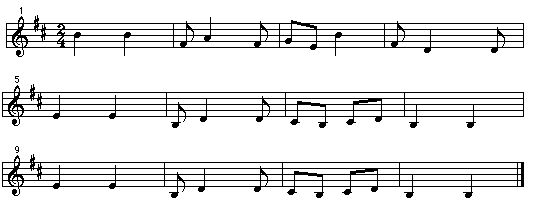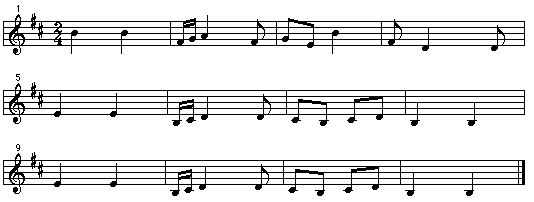

Melodic Analysis
1. S look at melody (on board or overhead) and determine the key of the piece
2. list similarities, patterns, etc. within the main theme melody (ex: "micro-form" ABB)
3. find parallels between rhythm and melody (same "micro-form")
4. determine solfege syllables
5. remind S that the piece is in a minor key so
mi, la, and ti are lowered to me, le, and te
Syllables: Sign and Sing
1. hand out melody bells
2. T plays and identifies do, then plays the starting pitch (do this each time to aid inner hearing)
3. T signs first 4 measures while S think the pitches of the syllables
4. S join T in step 3
5. repeat steps 3 and 4 for each group of measures
6. think and sign whole melody without stopping
7. echo sing and sign the syllables, 4 measures at a time
8. sing and sign the whole melody without stopping
Performance on Melody Bells
1. sit on knees (legs and floor will be "melody bells")
2. call floor to right of knees high do and floor to left of knees low do
3. speak letter names in rhythm
4. speak letter names and tap at approximate note (forward for sharps and flats), following L,R directions given above each note, 4 measures at a time (reminder: just sing "sharp" for sharp note or "flat" for flat note)
5. repeat step 4 with the recording
6. pick up melody bells and sing letters while pointing to bells (use correct hand)
7. repeat above step with recording
8. say letter names and play with the opposite ends of the sticks
9. add recording
10. when S have "got it", play with the right end of the mallets
11. add recording
12. play through some of the variations that are
at a faster tempo to challenge the class

Compare/Contrast Variations
1. show overhead or handout of the theme and the main melodic variations (as given above)
2. compare and contrast each variation with the theme
3. listen to the piece, one variation at a time to determine what Gliere did with the melody (in addition to embellishing it) to vary it
4. using steps 2 and 3, S make a "call chart" as a way of keeping track of which variation they are listening to (example: under description, instead of giving the form, give a description of the melody. This may not be a true call chart, but it is a similar device)
Creating a Variation
*This also could be used to teach Theme and Variation form- it is an activity that directly ties the melodic, rhythmic and form sections together
1. review and compile a list of variation devices (both rhythmic and melodic)
2. give students an specified amount of time to come up with their own variation
3. require that the students identify what variation device(s) they are using
4. allow each student to perform his/her variation
in front of the class
Extension: Composing a piece using theme and variation
1. S (in groups or individually) create a new theme based on G pentatonic tones
2. S develop at least 3 variations of the new theme, using the listening ex